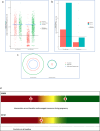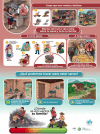Development of personal air pollution exposure report-back materials to Household Air Pollution Intervention Network (HAPIN) trial participants in Guatemala and Rwanda: a qualitative study
- PMID: 40379277
- PMCID: PMC12083286
- DOI: 10.1136/bmjgh-2024-017672
Development of personal air pollution exposure report-back materials to Household Air Pollution Intervention Network (HAPIN) trial participants in Guatemala and Rwanda: a qualitative study
Abstract
Background: Report-back of individual exposure information to research participants is recognised in high-income countries as an important, yet often overlooked, component of environmental research, with many potential benefits to study communities. Nonetheless, the optimal means of communicating findings to participants in low-income countries with limited health and scientific literacy is unknown.
Methods: Between March 2021 and May 2022, we conducted a qualitative study with 61 women and 20 of their household members (n=81) participating in the Household Air Pollution Intervention Network trial in Guatemala and Rwanda. Using participant observations and individual interviews (n=61), group interviews (n=21), dynamic working groups (n=78) and focus groups (n=45), we collaborated with study participants to iteratively develop contextually appropriate and comprehensible materials that conveyed individual air pollution exposures.
Results: Posters were generated to display graphical representations of participants' personal air pollution exposures, along with the known health effects of air pollution exposure and actions that could be taken to reduce their exposures to household air pollution.
Discussion: This is the first study to report back personal household air pollution exposure results to study participants in two low-income countries where people rely on biomass fuel (eg, wood, crop waste, dung) for cooking. We used community-engaged methods to co-produce locally and contextually specific materials.
Trial registration number: NCT02944682.
Keywords: Global Health; Pneumonia; Qualitative study.
© Author(s) (or their employer(s)) 2025. Re-use permitted under CC BY. Published by BMJ Group.
Conflict of interest statement
Competing interests: None declared.
Figures




References
-
- National Academies of Sciences, Engineering, and Medicine, Board on Health Sciences Policy, Health and Medicine Division . Returning individual research results to participants: Guidance for a new research paradigm. Washington, D.C: National Academies Press; 2018. - PubMed
Publication types
MeSH terms
Associated data
LinkOut - more resources
Full Text Sources
Medical
